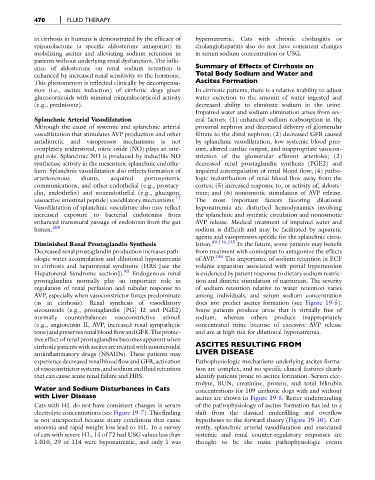Page 482 - Fluid, Electrolyte, and Acid-Base Disorders in Small Animal Practice
P. 482
470 FLUID THERAPY
in cirrhosis in humans is demonstrated by the efficacy of hypernatremic. Cats with chronic cholangitis or
spironolactone (a specific aldosterone antagonist) in cholangiohepatitis also do not have consistent changes
mobilizing ascites and alleviating sodium retention in in serum sodium concentration or USG.
patients without underlying renal dysfunction. The influ-
ence of aldosterone on renal sodium retention is Summary of Effects of Cirrhosis on
enhanced by increased renal sensitivity to the hormone. Total Body Sodium and Water and
This phenomenon is reflected clinically by decompensa- Ascites Formation
tion (i.e., ascites induction) of cirrhotic dogs given In cirrhotic patients, there is a relative inability to adjust
glucocorticoids with minimal mineralocorticoid activity water excretion to the amount of water ingested and
(e.g., prednisone). decreased ability to eliminate sodium in the urine.
Impaired water and sodium elimination arises from sev-
Splanchnic Arterial Vasodilatation eral factors: (1) enhanced sodium reabsorption in the
Although the cause of systemic and splanchnic arterial proximal nephron and decreased delivery of glomerular
vasodilatation that stimulates AVP production and other filtrate to the distal nephron; (2) decreased GFR caused
antidiuretic and vasopressor mechanisms is not by splanchnic vasodilatation, low systemic blood pres-
completely understood, nitric oxide (NO) plays an inte- sure, altered cardiac output, and inappropriate vasocon-
gral role. Splanchnic NO is produced by inducible NO striction of the glomerular efferent arterioles; (3)
synthetase activity in the mesenteric splanchnic endothe- decreased renal prostaglandin synthesis (PGE2) and
lium. Splanchnic vasodilatation also reflects formation of impaired autoregulation of renal blood flow; (4) patho-
arteriovenous shunts, acquired portosystemic logic redistribution of renal blood flow away from the
communications, and other endothelial (e.g., prostacy- cortex; (5) increased response to, or activity of, aldoste-
clin, endothelin) and nonendothelial (e.g., glucagon, rone; and (6) nonosmotic stimulation of AVP release.
vasoactive intestinal peptide) vasodilatory mechanisms. 11 The most important factors favoring dilutional
Vasodilatation of splanchnic vasculature also may reflect hyponatremia are disturbed hemodynamics involving
increased exposure to bacterial endotoxins from the splanchnic and systemic circulation and nonosmotic
enhanced transmural passage of endotoxin from the gut AVP release. Medical treatment of impaired water and
lumen. 208 sodium is difficult and may be facilitated by aquaretic
agents and vasopressors specific for the splanchnic circu-
Diminished Renal Prostaglandin Synthesis lation. 89,116,235 In the future, some patients may benefit
Decreased renal prostaglandin production increases path- from treatment with conivaptan to antagonize the effects
ologic water accumulation and dilutional hyponatremia of AVP. 240 The importance of sodium retention in ECF
in cirrhosis and hepatorenal syndrome (HRS [see the volume expansion associated with portal hypertension
Hepatorenal Syndrome section]). 90 Endogenous renal is evidenced by patient response to dietary sodium restric-
prostaglandins normally play an important role in tion and diuretic stimulation of natriuresis. The severity
regulation of renal perfusion and tubular response to of sodium retention relative to water retention varies
AVP, especially when vasoconstrictor forces predominate among individuals, and serum sodium concentration
(as in cirrhosis). Renal synthesis of vasodilatory does not predict ascites formation (see Figure 19-5).
eicosanoids (e.g., prostaglandin [PG] I2 and PGE2) Some patients produce urine that is virtually free of
normally counterbalances vasoconstrictive stimuli sodium, whereas others produce inappropriately
(e.g., angiotensin II, AVP, increased renal sympathetic concentrated urine because of excessive AVP release
tone)andpreservesrenalbloodflowandGFR.Theprotec- and are at high risk for dilutional hyponatremia.
tive effect of renal prostaglandins becomes apparent when
cirrhotic patients with ascites are treated with nonsteroidal ASCITES RESULTING FROM
antiinflammatory drugs (NSAIDs). These patients may LIVER DISEASE
experiencedecreasedrenalbloodflowandGFR,activation Pathophysiologic mechanisms underlying ascites forma-
of vasoconstrictor systems, and sodium and fluid retention tion are complex, and no specific clinical features clearly
that can cause acute renal failure and HRS. identify patients prone to ascites formation. Serum elec-
trolyte, BUN, creatinine, protein, and total bilirubin
Water and Sodium Disturbances in Cats concentrations for 109 cirrhotic dogs with and without
with Liver Disease ascites are shown in Figure 19-5. Better understanding
Cats with HL do not have consistent changes in serum of the pathophysiology of ascites formation has led to a
electrolyte concentrations (see Figure 19-7). This finding shift from the classical underfilling and overflow
is not unexpected because many conditions that cause hypotheses to the forward theory (Figure 19-10). Cur-
anorexia and rapid weight loss lead to HL. In a survey rently, splanchnic arterial vasodilatation and associated
of cats with severe HL, 14 of 72 had USG values less than systemic and renal counter-regulatory responses are
1.010, 29 of 114 were hyponatremic, and only 1 was thought to be the main pathophysiologic events

